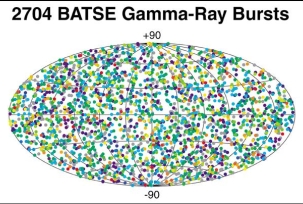Brightest of a sequence of images of the gamma ray burst
Click on image for full size
Image courtesy of ROTSE
Scientists Image Gamma Ray Burst As It Occurs
News story originally written on January 30, 1999
Last week scientists were able to take the first pictures of a
gamma ray burst while it was occuring.
In just 22 seconds after detection of the burst by the Burst and
Transient Source Experiment (BATSE) aboard the Compton Gamma Ray
Observatory, scientists with the Robotic Optical Transient Search
Experiment (ROTSE) began to take images of the event. Five seconds after
they started observering it, the burst reached its peak intensity.
"If this burst had originated in the Milky Way Galaxy, it would have lit
up the night sky," said Dr. Alan Bunner, Director of NASA's Structure and
Evolution of the Universe science theme at NASA Headquarters.
Up until now, scientists had only been able to capture the afterglow of
the events and never the burst itself. Hopefully these images and others
that can be collected using similar automated detection systems will help
scientists determine what causes gamma ray bursts.
You might also be interested in:

In the 1960's, the United States launched a series of satellites to look for very high energy photons, called Gamma Rays, that are produced whenever a nuclear bomb explodes. These satellites soon detected
...more
It was another exciting and frustrating year for the space science program. It seemed that every step forward led to one backwards. Either way, NASA led the way to a great century of discovery. Unfortunately,
...more
The Space Shuttle Discovery lifted off from Kennedy Space Center at 2:19 p.m. EST, October 29th. The sky was clear and the weather was great as Discovery took 8 1/2 minutes to reach orbit for the Unitied
...more
A moon was discovered orbiting the asteroid, Eugenia. This is only the second time in history that a satellite has been seen circling an asteroid. A special mirror allowed scientists to find the moon
...more
Will Russia ever put the service module for the International Space Station in space? NASA officials are demanding an answer from the Russian government. The necessary service module is currently waiting
...more
During a period of about two days in early May, 1998, the ACE spacecraft was immersed in plasma associated with a coronal mass ejection (CME). The SWICS instrument on ACE, which determines unambiguously
...more
J.S. Maini of the Canadian Forest Service has referred to forests as the "heart and lungs of the world." Forests reduce soil erosion, maintain water quality, contribute to atmospheric humidity and cloud
...more









